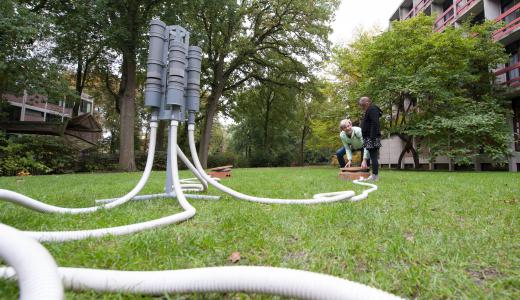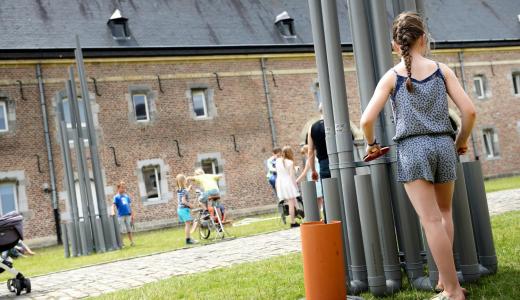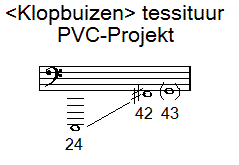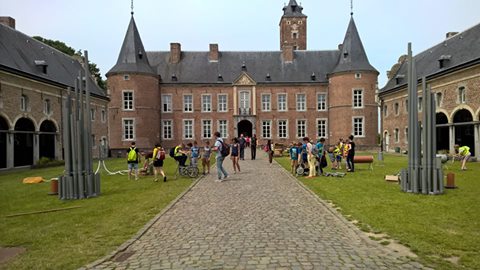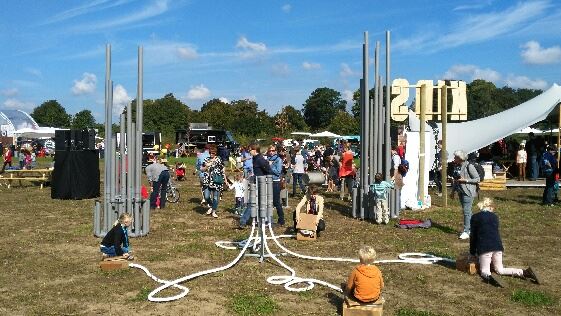
| Facility: | tetrahedron | studio | laboratory | workshop | archive | shop | documentation center |
Logos Instrument Building Workshop
|
PVC Project commissioned by Musica vzw (2015-2017)
Description The idea is to design and build a modular yet consistent instrument using PVC material that could be played by many children in togetherness. The instrument should be transportable in a small van and mounting complexity should be low and take up a minimum of time. Sturdiness is essential as well as safety. Weather resistance was also a design issue.
Realisation / Realisatie: 1.- Twee modules met elk 12 klopbuizen voorzien van opzetstukken waarmee de tonen kunnen worden gekozen. Bij elke module hoort een houder voor de ping pong paletten voorzien van een speciale laag zacht neopreen.
2.- Twee Intonarumori instrumenten met membraan, spanmekanisme en door een zwengel bediend strijkwiel. 3.- Een module met vier kalliopes voorzien van vier balgen en verbonden met witte flexibele PVC buizen. De module is in hoogte verstelbaar. 4.- Twee home-trainer zingende fietsen, elk met twee resonantiebuizen in PVC 5.- Twee draadstang modules met membraan ringschrijven en omkeermekaniek. (omgebouwd tot rommelpotten in 2017) 6.- Twee rommelpotten (2017) 7.- Vier schuiffluitmodules (2017)
Earlier projects and compositions by Godfried-Willem Raes using PVC pipes:
Collaborators in the realisation and construction of this project:
Construction diary: 15.07.2014: Sketches for what mechanisms could be made using PVC
pipes: 01-16.02.2015: Experiments carried out with different kinds of PVC. The idea to make PVC logdrums came out to be unworkable. So this design was cancelled from the list of possibilities. 17-18.02.2015: Construction of drums using large diameter PVC pipes by Mattias Parent. Although this works very well, we did not preserve them in the final project by lack of originality. The drums may be modified to large lions roars later. 21.02.2015:Construction of an experimental giant whisper, using
vinyl LP records 02.05.2015: Singing bicyle, with two tones mounted on a home trainer: 27-28.05.2015: Further work on the string tending mechanism in nylon and definitive mounting of the crank. Definitive studbolt mounted for limitation of the range for the tending mechanism. 30.05.2015: A new load of PVC pipe cames flowing in... 02-04.05.2015: Construction of the bellows for the kalliopes 06-07.05.2015: Construction of the second intonarumori instrument. 10-15.06.2015: Cutting, drilling and TIG-welding works on the hexagonal
holding structures for the tube resonators. Each module will hold
12 tubes, 90 mm in diameter. The diameter of the complete module
will become 1100 mm. There are two such modules, so in total 24
tubes. 16.06.2014: Mounting of the PVC tubes in the structure. 17.06.2015: Different kinds of neoprene and rubbers tested for the construction of the playing pallets. 18.06.2015: Two modules ready. All exchangeable pipe lengths sawn off and tuned. Design alternatives for the kalliopes drawn out and studied. 19.06.2015: Welding and final construction works on the second intonarumori instrument. This will be made from orange sewer pipe PVC, 20.06.2015: Sawing, precision drilling and welding of the steel
holder for the four kalliopes. 21.06.2015: Painting of the welded construction. Mounting of the
kalliopes. 22.06.2015: Finalising the construction of the threaded rod instruments:
clamping mechanism and welding of the studs connecting both T's
pieces. The painting still has to be done. 23.06.2015: Finishing of the second intonarumori instrument. 24.06.2015: Final painting of all modules. Construction of the beaters for the drum-tubes. Instrumental setup demonstration for Musica. 25.06.2015: Printing of the labels with the pitches for the pipes. 26.06.2015: Transport of the project to Musica in Limburg. Setup and installation Laura Maes and Mattias Parent at Alden Biesen. Some issues to be remedied are: the bikes are too loud in comparisson to the other modules. The threaded rods are too gentle. The first issue can be solved by placing a series resistor in the wires to the speakers. The second one, to replace the ring with heavier ones and to exchange the membrane with styrofoam. 28.06.2015: Premiere of the project at AlbaNova organized by Musica
at Alden Biesen. 2016: Parkbos installatie: }10-13.08.2017: Construction of two easy to play lions roar modules:
[Konstruktie van twee rommelpotten:| 14.08-18.08.2017: {Konstruktie van de eerste twee schuiffluit modules:}
19.08.2017: Design of the lower slide whistles. Here we are using much larger pumps. So we selected Quechua pumps with an air content of 5.2 liters. The flue pipes in this case were a lot more difficult to make, as we had to make the slide-piece and the flute block completely from scratch. In fact we used a piece of aluminum tube turned on the lathe and filled with epoxy rosin (Seno 4046, produced for the encapsulation of electronic circuits). The epoxy compound needs 24 hours to cure, so we had to interrupt the works and just wait... 20.08.2017: Further construction of the slide whistles.The bass
whistle uses a PVC tube, 40 mm x 1.8. The sliding plunger thus has
to be just a bit (ca. 0.2 mm) smaller than 36.4 mm. This plunger
was fabricated using aluminum tube filled with epoxy rosin. The
result is not too great, as gently sliding remains problematic,
even when greased with vaselin. Apparently the PVC tube itself is
not pure cilindric... The larger pumps used to drive this whistle
give some problems as well, as their movement is not very fluent
neither. They do not seem to work as well on low pressures as the
Jobe pumps used for the smaller pipes.
Todo: add musical scales to the fingerboards on the slide whistle modules |
